Electric vehicles are frequently acclaimed as a major means to cut emissions and thereby prevent climate change. Still, research on the simultaneous benefits of reduced air pollution and enhanced health has been largely speculative.
In the first study to use real-world data to correlate electric cars, air pollution, and health, a team of researchers from USC’s Keck School of Medicine has begun to study the actual impact of electric vehicle adoption. Using publicly available records, the researchers examined a “natural experiment” in California as citizens quickly shifted to electric cars or light-duty zero-emission vehicles (ZEVs).
Between 2013 and 2019, the researchers analyzed data on overall ZEV registration, air pollution levels, and asthma-related emergency department visits across the state. Local air pollution and emergency department visits decreased as ZEV adoption increased within a given zip code.
“When we think about the actions related to climate change, often it’s on a global level,” said Erika Garcia, Ph.D., MPH, an assistant professor of population and public health sciences at the Keck School of Medicine and the study’s lead author.

“But the idea that changes being made at the local level can improve the health of your community could be a powerful message to the public and policymakers.”
The researchers also discovered that, while overall ZEVs increased over time, adoption was slower in low-resource zip codes, a phenomenon known as the “adoption gap.” This disparity suggests an opportunity to restore environmental justice in communities that have been disproportionately impacted by pollution and related health issues.
“The impacts of climate change on health can be challenging to talk about because they can feel very scary,” said Sandrah Eckel, Ph.D., an associate professor of population and public health sciences at the Keck School of Medicine and the study’s senior author.
“We’re excited about shifting the conversation towards climate change mitigation and adaptation, and these results suggest that transitioning to ZEVs is a key piece of that.”

The research team evaluated and contrasted four distinct datasets to investigate the implications of electric car adoption. They began by obtaining data on ZEVs (which include battery electric, plug-in hybrid, and hydrogen fuel cell vehicles) from the California Department of Motor Vehicles and tabulating the total number registered in each zip code between 2013 and 2019.
They also gathered data from US Environmental Protection Agency air monitoring sites on nitrogen dioxide (NO2) levels, a traffic-related air pollutant, and zip code level asthma-related emergency department visits.

Finally, the researchers determined the percentage of adults with bachelor’s degrees in each zip code. Educational attainment is widely used to predict a neighborhood’s socioeconomic standing.
There was a 3.2 percent drop in the rate of asthma-related emergency visits and a slight suggestive reduction in NO2 levels for every additional 20 ZEVs per 1,000 individuals at the zip code level. ZEVs climbed from 1.4 to 14.6 per 1,000 occupants on average across the state’s zip codes between 2013 and 2019.

ZEV adoption was much lower in zip codes with lower educational attainment levels. For example, a zip code with 17 percent of the population having a bachelor’s degree had an annual rise of 0.70 ZEVs per 1,000 people, compared to a zip code with 47 percent of the population having a bachelor’s degree, which had a yearly increase of 3.6 ZEVs per 1,000 people.
A previous study has indicated that disadvantaged groups, such as low-income areas, have higher pollution levels and respiratory difficulties than more affluent areas. Therefore, they could benefit significantly if ZEVs replace gas-powered cars in such neighborhoods.
While climate change is a massive health threat, mitigating it offers a huge public health opportunity. As one of the first studies to quantify the real-world environmental and health benefits of ZEVs, the research can help demonstrate the power of this mitigation measure, including possibly reduced healthcare utilization and expenditures.
Garcia believes the findings are promising, but many challenges linger. Further implications of ZEVs should be studied in the future, such as emissions from brake and tire wear, mining resources for construction, and disposal of obsolete automobiles.
The researchers also plan to investigate new types of pollutants and vehicle classifications and conduct a follow-up study on the consequences of the state’s rising use of ZEVs.
According to Eckel, the transition to ZEVs is only one part of the solution. Other essential approaches to improve environmental and public health include public transportation and active transportation, such as walking and biking.
The study was published in the journal Science of the Total Environment.


